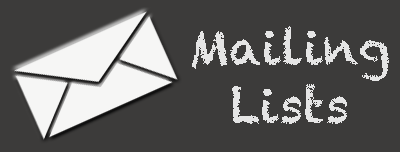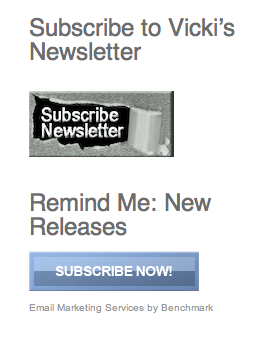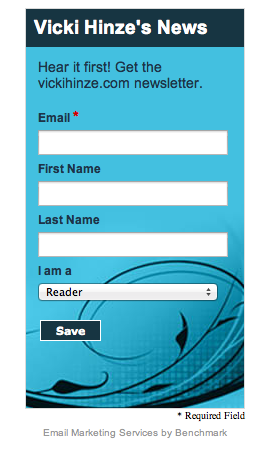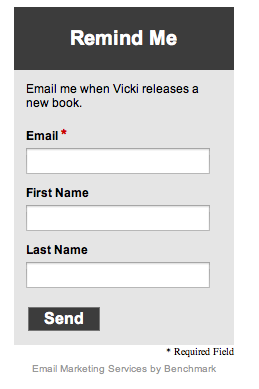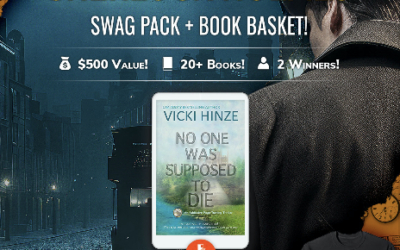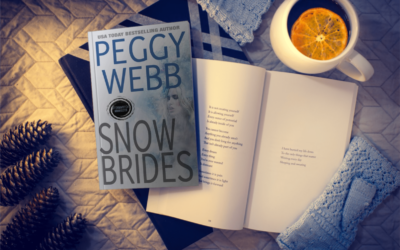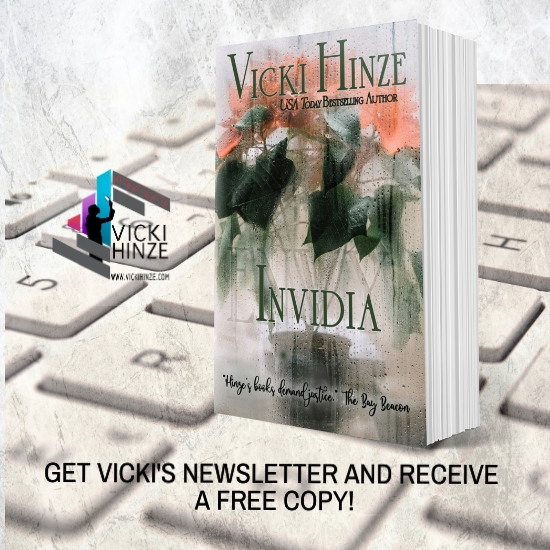Last Friday, a blog post on this subject ran on my agent, Chip MacGregor’s site. I’m including it here in the On Writing blog to incorporate it into the Writing Library.
© 2013, Vicki HInze
For decades, Authors have been told there are two things they really should do:
1. A website.
2. A newsletter.
The website is self-explanatory, and I’ll discuss it in more depth in another article. For now, it’s sufficient to say that when readers, booksellers, or industry professionals are interested in an author or intrigued by something an author did or said–or something else has spurred curiosity–these people first look to the author’s website to find out more about that author.
They often skip the search engine “search” and go straight to the author’s name followed by .com. That’s the biggest reason you’re advised to try to get your name (or pseudonym, if you use one) as a URL and to setup your site (author’s name).com.
The newsletter is a bit more tricky. There are multiple reasons why they’re a good idea. Here are a few:
1. It’s the author’s personal connection to the reader. A dialogue, if you will, that is between just the two of you.
2. It’s an efficient way to exchange information, to keep readers current on what’s going on with the author’s work.
3. It’s essential to notify readers of special events and special deals of interest to them. (For example, for one day or one month, a bookseller has reduced the price of your $15.99 book to $5.60. That’s helpful information for readers.
How to let them know brings us to newsletters, and that brings us to mailing lists: the means through which we can connect for those purposes. I hear authors groaning already about another writing-related task that keeps them from writing the books, but let me share that your mailing list is an enormously valuable asset. Why?
I touched on the personal connection and information sharing and awareness factors above. But this is also the author’s opportunity to create bonds. They’re important–to authors but also to readers. In your newsletter, readers see a little deeper into the author or into the work. Maybe you do an exclusive note to them about why you wrote the book. Give them a sneak peek behind the proverbial curtain. Or you offer them something in your newsletter that they don’t see elsewhere. Newsletter readers become insiders into your world and feel treasured by you, and they should be treasured by you!
A newsletter isn’t and should never be a commercial. Readers are bombarded by plenty of those. Your newsletter should be informative but also have something special for those interested enough and supportive enough to opt-in to your mailing list to keep up to date on your activities. So treat the readers behind the newsletter (whether they are readers, booksellers, librarians or other industry professionals) with the respect they deserve. Yes, tell them what’s available and new, but also chat with them and not just to them.
Never send newsletters to those who have not specifically opted to receive them. Opt-in only. There are laws on this, and against spamming. Honor them and respect your readers. Give them the chance to join your mailing list, yes. But if they don’t choose to do so, don’t send your newsletter to them anyway. That’s illegal and rude. It will also get you blacklisted, and that means your emails are bounced by servers and not sent to recipients. You’re officially tagged as a spammer. This impacts not only your ability to send newsletters, but also your ability to send not just newsletters but any email!
So how do you manage your mailing lists?
There are many ways, of course, but with the conviction that it works, I can share how I do mine.
I maintain two lists: one for the newsletter and one I call the Remind Me list, which I’ll explain in a moment. First, let’s look at the Newsletter list. It’s divided into three groups, or lists:
1. Readers.
2. Booksellers.
3. Librarians.
The reader’s list is tagged a general list and it’s the group to whom newsletters go. But there are times when you have something to share that is only of interest to select groups–say, booksellers or librarians. You don’t want to include that level or depth of information in your general newsletter so you create a special newsletter or news blast for the intended group–be that booksellers or librarians. (Alternately, you might have a fiction and non-fiction list. Those who are interested in one well might not be interested in the other. You’ll know your areas of specialty and how to break your list so that what you send out is relevant to the intended recipients.)
An example: Recently, my three Seascape series novels were reissued as “Clean Reads.” These are hard cover and particularly of interest to librarians. The books were originally published for the general market but have been revised to fit the needs of this specific group. All three of the books have now been released, and while I’ve mentioned their release (because my faith-affirming, inspirational readers might also find these books of interest), I need to do a special, short news release to librarians on these new Clean Reads versions.
This enables me to let those who want to know these things know them, but doesn’t clutter everyone’s mailbox with a special newsletter they don’t need. So it’s mentioned in the general newsletter, and interested parties get a special news blast giving them important additional details they need.
Yes, it’s more work for the author. But it’s worthy work because it respects the people receiving the messages, and that is extremely important–or it should be extremely important to the author.
Now, we’re all busy and have nine million things tugging at us all the time shouting, “Me next!” Because I recognize that, I also keep a separate mailing list for those who want to know when a new book is released but that’s really all they want to know due to their own time constraints. Accommodating them, I have the REMIND ME list.
The only thing I send those who opt-in for the REMIND ME list is a short note when a new book is released. It lets them know the new book is available and in what format (print, digital, audio. Whether it’s hard cover, trade or mass market paperback.) That’s it. Ten seconds or less and they’ve read it and are aware of the new book.
The signup forms for the Newsletter and Remind Me lists are different. Here are screenshots of what I use for each of them:
The above graphic is a screenshot of the Sidebar that’s on most pages of my vickihinze.com website.
Note that I used two very different buttons, so it’s blatant that there are two different options here (though many do sign up for both) and that negates any confusion.
When you click “Subscribe Newsletter,” this form comes up:
Note it’s quick and easy, and the only information required is the email address.
Also note the “I am a” in the last box. If you click the arrow on the right of “Reader,” you’ll see “Bookseller” and “Librarian.” Important for the reasons stated above and it provides a simple way to sort to send something geared specifically to Booksellers or Librarians quickly and easily. Often, they need information readers do not, so it’s helpful for the author to have that option.
When you click the Remind Me “Subscribe Now” button, this form comes up:
Again, quick and easy, and only the email address is required.
To see this function on the website, click any of the graphics discussed and it’ll take you to one of my pages. I know that actually seeing something operational often helps me.
Privacy policy. You should make it clear that you have a privacy policy in place. Typically that’s posted on your website, but it should be on the subscription confirmation form (after people signup, they receive a note confirming that they really did sign up [and weren’t being impersonated]) or on a “thanks for joining me” type of response for having signed up.
Yes, that responder is another step the author must take. But look at it this way: When you sign up for one thing and find your email has been shared, you don’t appreciate it. No one else appreciates it, either. So create a privacy policy, blatantly state it, and fastidiously adhere to it. The statement doesn’t have to be fancy. Blunt works great:
Your privacy is respected. Your information will not be shared.
That does the trick.
Let me close by saying you have no idea how valuable an asset your mailing list is until you lose it. A few years ago, I had well over 100,000 opt-in readers on my general list, several thousand on the bookseller list, and over 20,000 on my librarian’s list.
My computer was hacked, which resulted in a safety feature kicking in that destroyed everything on my hard drive. So they didn’t get any information, but my hard drive was wiped out. Unfortunately for me, my external hard drive backup was connected at the time, so it too was corrupted. Not wiped out but so severely corrupted that nothing on it was recoverable. I lost everything.
Worse than the loss of the mailing lists was the loss of the connections I’d built over many years. Multiple computer gurus tried to recover the lists (and photos and important documents) but couldn’t salvage a thing. I had to accept that I had to start over. And so I did. That loss is felt acutely even today.
Several lessons in that for me that I share with you:
1. Don’t keep your external hard drive connected to your computer unless you’re using it.
2. Understand the value of your mailing list–it’s your connection to your readers.
3. Make multiple backup copies of your mailing lists and store them in multiple places. Even that won’t totally protect you from loss, particularly if someone else maintains your list for you. But if that’s the case, then suspense your calendar to do monthly backup downloads so you have current copies. People subscribe, unsubscribe, change their email addresses and such all the time. This way, if you need to start again, you have a base that isn’t out of date by so much that the required verification forms sent (to be sure the person really does want to subscribe to your list) don’t bounce at a rate that qualifies you as a spammer.
Let me explain that verification form business just mentioned. Every time you switch providers of a mailing list service, the new one must send a verification form to each subscriber to be sure they want your email and you’re not spamming them from some list you bought somewhere. The subscriber must click a confirmation link or s/he is off your list. Most companies will send these verification forms one time only. So when you change service providers, you might only retain 10 or 15% of your subscribers. It’s totally a matter of the subscriber clicking that email link.
This is another reason to make sure your list stays “clean” and up-to-date. If it doesn’t, and you either switch servers or need to start over from a backup and a lot of the verifications emailed by your service provider to your subscribers bounce or are refused, then you’re deemed a spammer. That can impact not only your mailing list emails but all your emails. So you have to keep your list clean and up-to-date!
I hope this helps not only show you the value of mailing lists but also helps you avoid pitfalls and challenges in creating and maintaining them.
Blessings,
Vicki


